HSDV7350: Needs Assessment Plan: Heart Foundation, New Zealand
VerifiedAdded on 2023/04/07
|11
|2278
|395
Report
AI Summary
This report details a needs assessment plan for the Heart Foundation in New Zealand, focusing on cardiovascular disease and the health needs of the population, particularly the aboriginal community. The plan outlines the organization's mission, operations, and the identified need for more research on healthy eating and nutrition to reduce heart disease and death rates. The report includes a summary of the issue, discussing the causes of cardiovascular disease, risk factors, and the impact on different demographics. It describes the data collection methods, involving interviews with individuals from the aboriginal community, and addresses ethical considerations, emphasizing informed consent and community participation. The analysis and use of results are also discussed, highlighting how the findings will inform the Heart Foundation's awareness programs. The report aims to contribute to the organization's mission of reducing heart disease rates by tailoring interventions to the specific needs of the community.
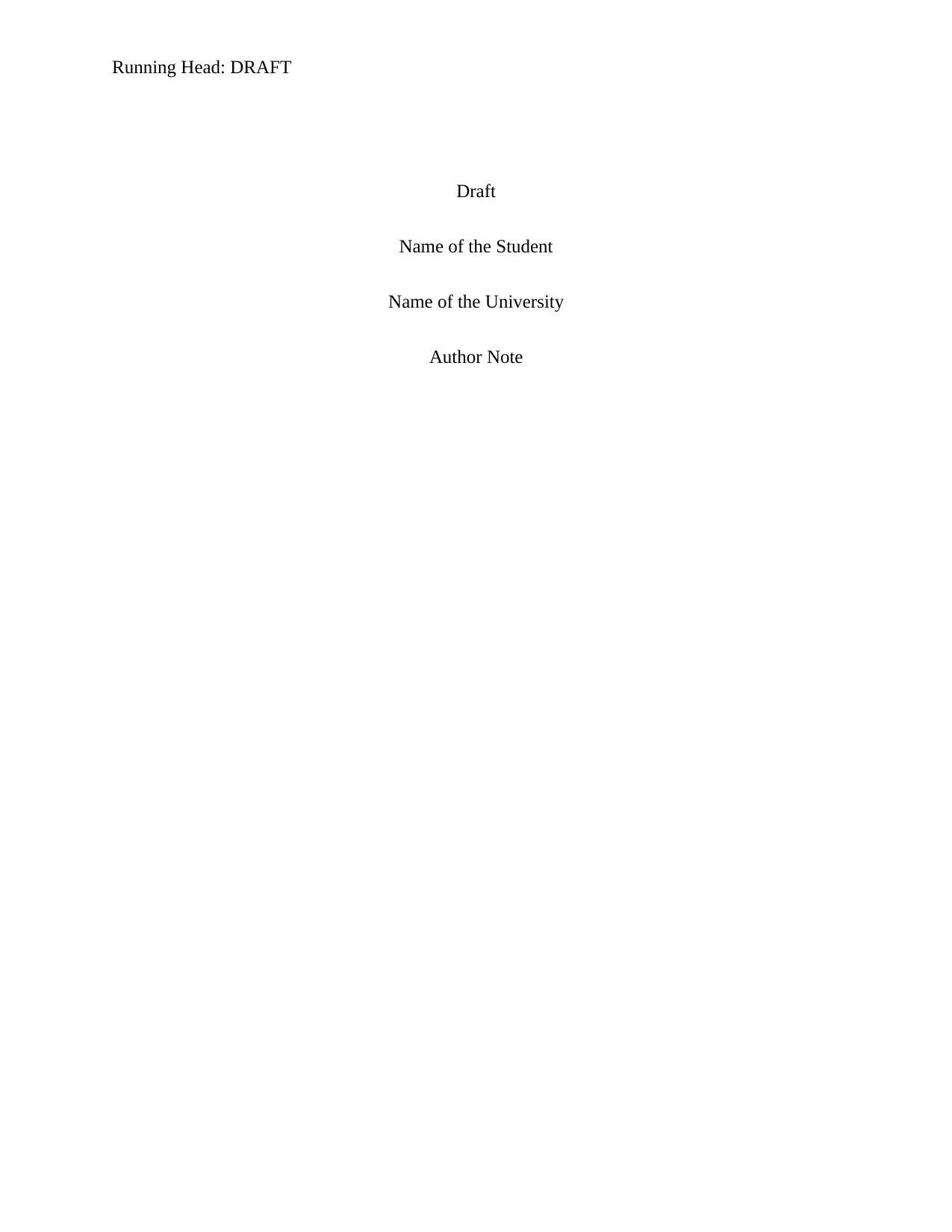
Running Head: DRAFT
Draft
Name of the Student
Name of the University
Author Note
Draft
Name of the Student
Name of the University
Author Note
Paraphrase This Document
Need a fresh take? Get an instant paraphrase of this document with our AI Paraphraser
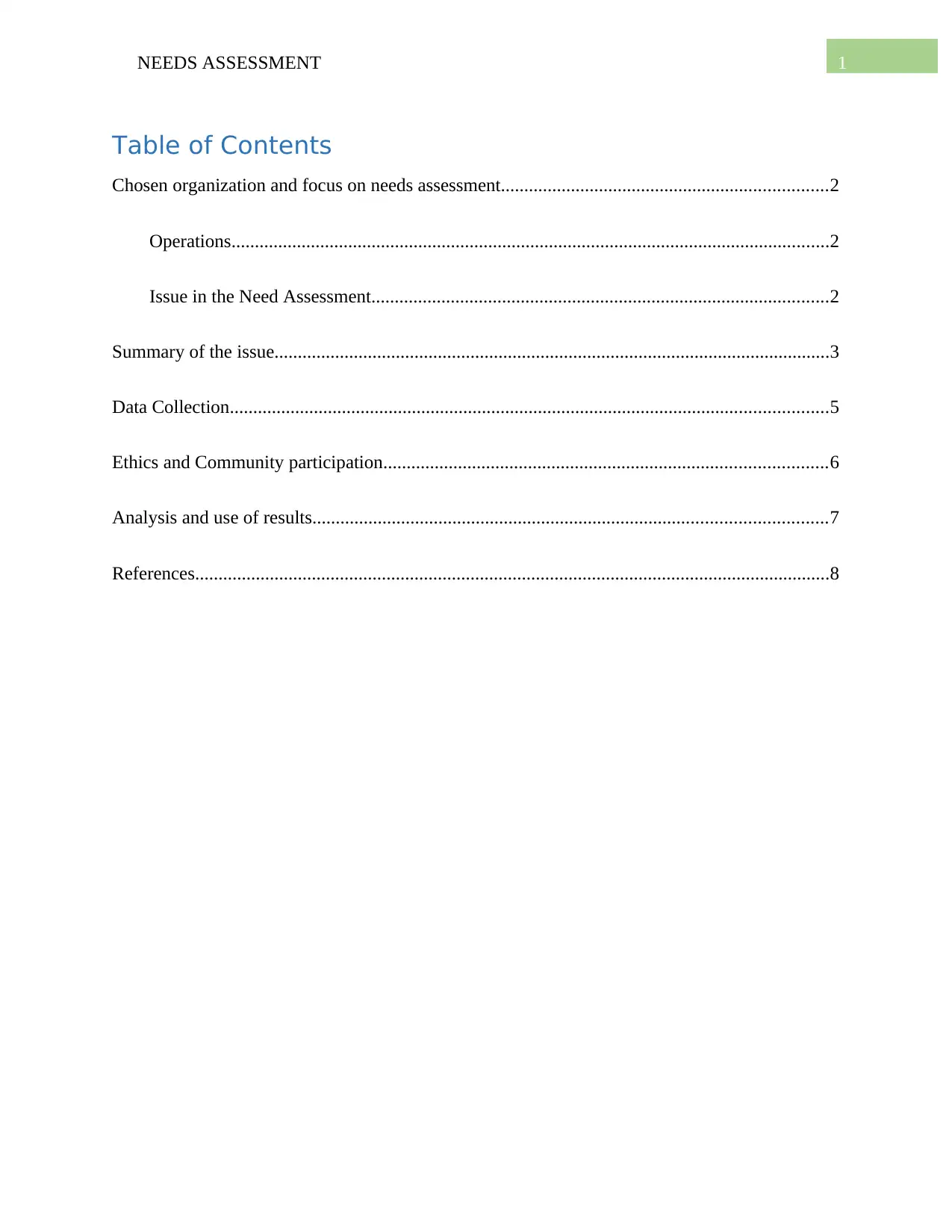
1NEEDS ASSESSMENT
Table of Contents
Chosen organization and focus on needs assessment......................................................................2
Operations................................................................................................................................2
Issue in the Need Assessment..................................................................................................2
Summary of the issue.......................................................................................................................3
Data Collection................................................................................................................................5
Ethics and Community participation...............................................................................................6
Analysis and use of results..............................................................................................................7
References........................................................................................................................................8
Table of Contents
Chosen organization and focus on needs assessment......................................................................2
Operations................................................................................................................................2
Issue in the Need Assessment..................................................................................................2
Summary of the issue.......................................................................................................................3
Data Collection................................................................................................................................5
Ethics and Community participation...............................................................................................6
Analysis and use of results..............................................................................................................7
References........................................................................................................................................8
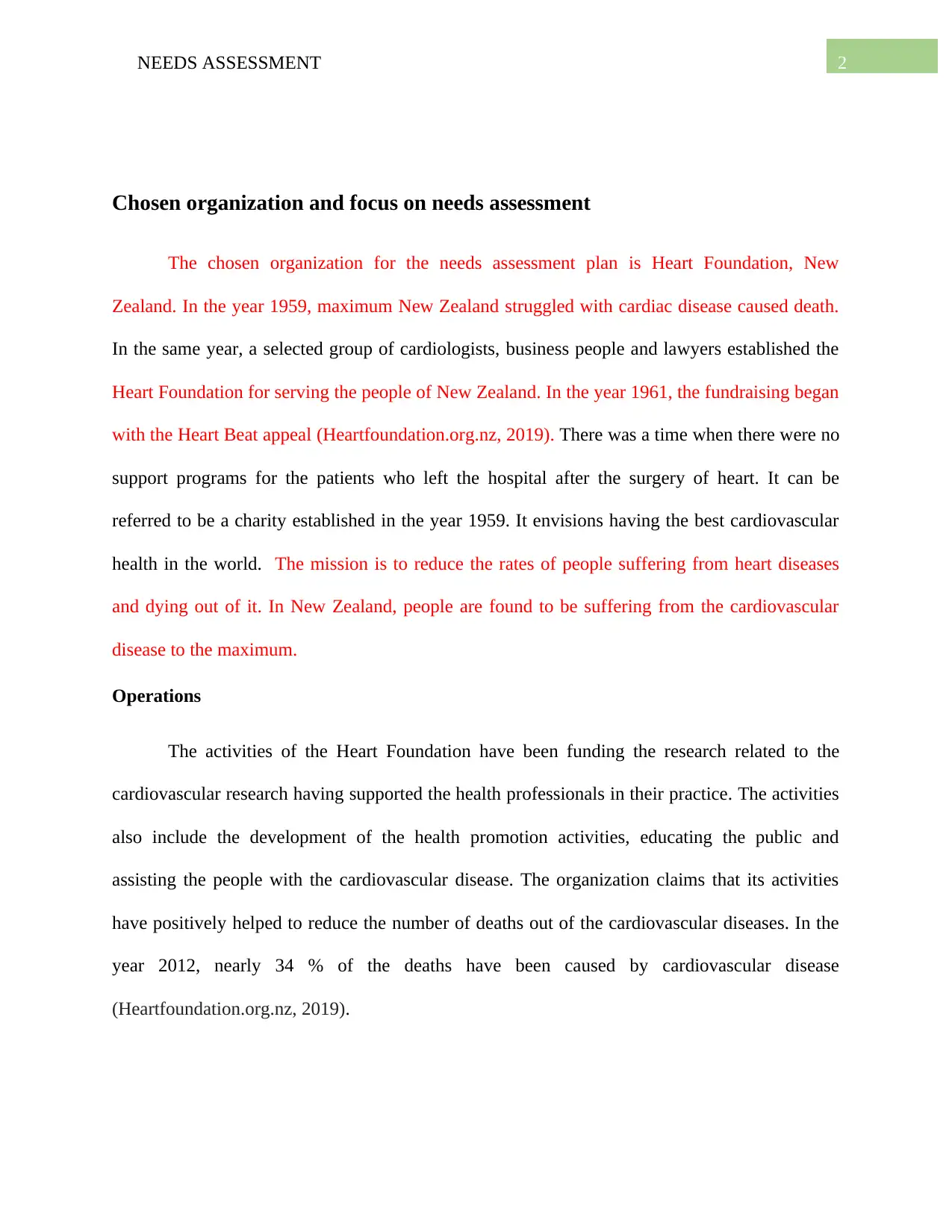
2NEEDS ASSESSMENT
Chosen organization and focus on needs assessment
The chosen organization for the needs assessment plan is Heart Foundation, New
Zealand. In the year 1959, maximum New Zealand struggled with cardiac disease caused death.
In the same year, a selected group of cardiologists, business people and lawyers established the
Heart Foundation for serving the people of New Zealand. In the year 1961, the fundraising began
with the Heart Beat appeal (Heartfoundation.org.nz, 2019). There was a time when there were no
support programs for the patients who left the hospital after the surgery of heart. It can be
referred to be a charity established in the year 1959. It envisions having the best cardiovascular
health in the world. The mission is to reduce the rates of people suffering from heart diseases
and dying out of it. In New Zealand, people are found to be suffering from the cardiovascular
disease to the maximum.
Operations
The activities of the Heart Foundation have been funding the research related to the
cardiovascular research having supported the health professionals in their practice. The activities
also include the development of the health promotion activities, educating the public and
assisting the people with the cardiovascular disease. The organization claims that its activities
have positively helped to reduce the number of deaths out of the cardiovascular diseases. In the
year 2012, nearly 34 % of the deaths have been caused by cardiovascular disease
(Heartfoundation.org.nz, 2019).
Chosen organization and focus on needs assessment
The chosen organization for the needs assessment plan is Heart Foundation, New
Zealand. In the year 1959, maximum New Zealand struggled with cardiac disease caused death.
In the same year, a selected group of cardiologists, business people and lawyers established the
Heart Foundation for serving the people of New Zealand. In the year 1961, the fundraising began
with the Heart Beat appeal (Heartfoundation.org.nz, 2019). There was a time when there were no
support programs for the patients who left the hospital after the surgery of heart. It can be
referred to be a charity established in the year 1959. It envisions having the best cardiovascular
health in the world. The mission is to reduce the rates of people suffering from heart diseases
and dying out of it. In New Zealand, people are found to be suffering from the cardiovascular
disease to the maximum.
Operations
The activities of the Heart Foundation have been funding the research related to the
cardiovascular research having supported the health professionals in their practice. The activities
also include the development of the health promotion activities, educating the public and
assisting the people with the cardiovascular disease. The organization claims that its activities
have positively helped to reduce the number of deaths out of the cardiovascular diseases. In the
year 2012, nearly 34 % of the deaths have been caused by cardiovascular disease
(Heartfoundation.org.nz, 2019).
⊘ This is a preview!⊘
Do you want full access?
Subscribe today to unlock all pages.

Trusted by 1+ million students worldwide
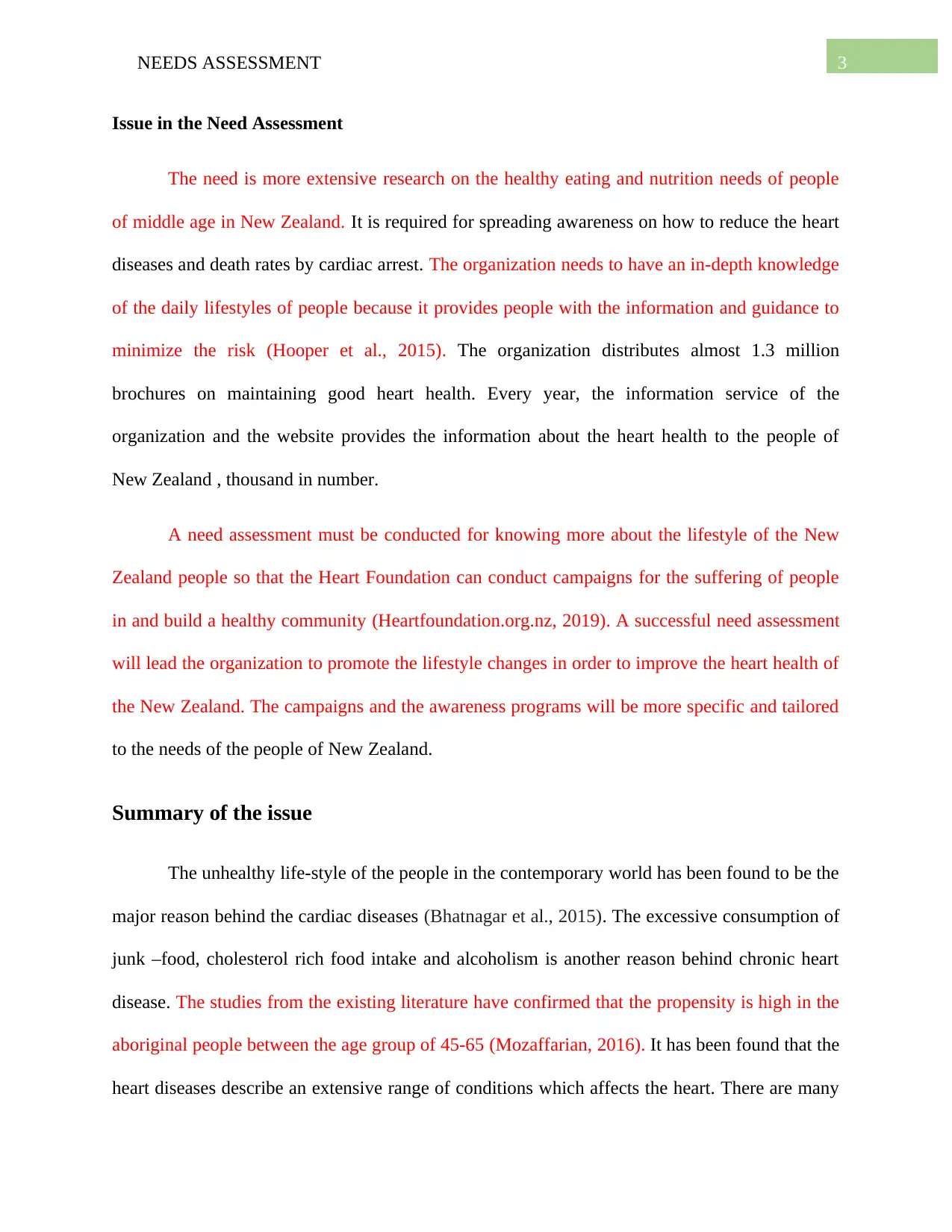
3NEEDS ASSESSMENT
Issue in the Need Assessment
The need is more extensive research on the healthy eating and nutrition needs of people
of middle age in New Zealand. It is required for spreading awareness on how to reduce the heart
diseases and death rates by cardiac arrest. The organization needs to have an in-depth knowledge
of the daily lifestyles of people because it provides people with the information and guidance to
minimize the risk (Hooper et al., 2015). The organization distributes almost 1.3 million
brochures on maintaining good heart health. Every year, the information service of the
organization and the website provides the information about the heart health to the people of
New Zealand , thousand in number.
A need assessment must be conducted for knowing more about the lifestyle of the New
Zealand people so that the Heart Foundation can conduct campaigns for the suffering of people
in and build a healthy community (Heartfoundation.org.nz, 2019). A successful need assessment
will lead the organization to promote the lifestyle changes in order to improve the heart health of
the New Zealand. The campaigns and the awareness programs will be more specific and tailored
to the needs of the people of New Zealand.
Summary of the issue
The unhealthy life-style of the people in the contemporary world has been found to be the
major reason behind the cardiac diseases (Bhatnagar et al., 2015). The excessive consumption of
junk –food, cholesterol rich food intake and alcoholism is another reason behind chronic heart
disease. The studies from the existing literature have confirmed that the propensity is high in the
aboriginal people between the age group of 45-65 (Mozaffarian, 2016). It has been found that the
heart diseases describe an extensive range of conditions which affects the heart. There are many
Issue in the Need Assessment
The need is more extensive research on the healthy eating and nutrition needs of people
of middle age in New Zealand. It is required for spreading awareness on how to reduce the heart
diseases and death rates by cardiac arrest. The organization needs to have an in-depth knowledge
of the daily lifestyles of people because it provides people with the information and guidance to
minimize the risk (Hooper et al., 2015). The organization distributes almost 1.3 million
brochures on maintaining good heart health. Every year, the information service of the
organization and the website provides the information about the heart health to the people of
New Zealand , thousand in number.
A need assessment must be conducted for knowing more about the lifestyle of the New
Zealand people so that the Heart Foundation can conduct campaigns for the suffering of people
in and build a healthy community (Heartfoundation.org.nz, 2019). A successful need assessment
will lead the organization to promote the lifestyle changes in order to improve the heart health of
the New Zealand. The campaigns and the awareness programs will be more specific and tailored
to the needs of the people of New Zealand.
Summary of the issue
The unhealthy life-style of the people in the contemporary world has been found to be the
major reason behind the cardiac diseases (Bhatnagar et al., 2015). The excessive consumption of
junk –food, cholesterol rich food intake and alcoholism is another reason behind chronic heart
disease. The studies from the existing literature have confirmed that the propensity is high in the
aboriginal people between the age group of 45-65 (Mozaffarian, 2016). It has been found that the
heart diseases describe an extensive range of conditions which affects the heart. There are many
Paraphrase This Document
Need a fresh take? Get an instant paraphrase of this document with our AI Paraphraser
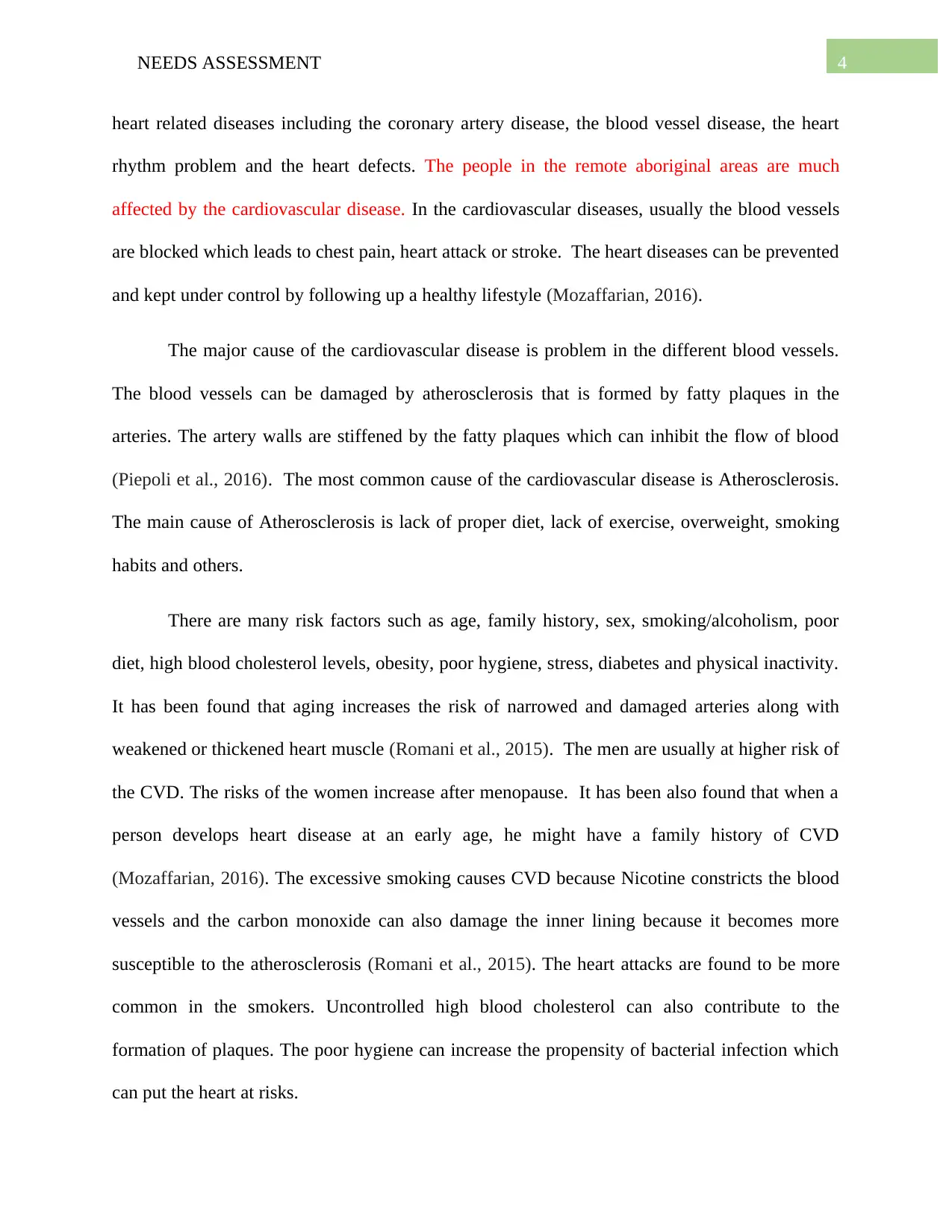
4NEEDS ASSESSMENT
heart related diseases including the coronary artery disease, the blood vessel disease, the heart
rhythm problem and the heart defects. The people in the remote aboriginal areas are much
affected by the cardiovascular disease. In the cardiovascular diseases, usually the blood vessels
are blocked which leads to chest pain, heart attack or stroke. The heart diseases can be prevented
and kept under control by following up a healthy lifestyle (Mozaffarian, 2016).
The major cause of the cardiovascular disease is problem in the different blood vessels.
The blood vessels can be damaged by atherosclerosis that is formed by fatty plaques in the
arteries. The artery walls are stiffened by the fatty plaques which can inhibit the flow of blood
(Piepoli et al., 2016). The most common cause of the cardiovascular disease is Atherosclerosis.
The main cause of Atherosclerosis is lack of proper diet, lack of exercise, overweight, smoking
habits and others.
There are many risk factors such as age, family history, sex, smoking/alcoholism, poor
diet, high blood cholesterol levels, obesity, poor hygiene, stress, diabetes and physical inactivity.
It has been found that aging increases the risk of narrowed and damaged arteries along with
weakened or thickened heart muscle (Romani et al., 2015). The men are usually at higher risk of
the CVD. The risks of the women increase after menopause. It has been also found that when a
person develops heart disease at an early age, he might have a family history of CVD
(Mozaffarian, 2016). The excessive smoking causes CVD because Nicotine constricts the blood
vessels and the carbon monoxide can also damage the inner lining because it becomes more
susceptible to the atherosclerosis (Romani et al., 2015). The heart attacks are found to be more
common in the smokers. Uncontrolled high blood cholesterol can also contribute to the
formation of plaques. The poor hygiene can increase the propensity of bacterial infection which
can put the heart at risks.
heart related diseases including the coronary artery disease, the blood vessel disease, the heart
rhythm problem and the heart defects. The people in the remote aboriginal areas are much
affected by the cardiovascular disease. In the cardiovascular diseases, usually the blood vessels
are blocked which leads to chest pain, heart attack or stroke. The heart diseases can be prevented
and kept under control by following up a healthy lifestyle (Mozaffarian, 2016).
The major cause of the cardiovascular disease is problem in the different blood vessels.
The blood vessels can be damaged by atherosclerosis that is formed by fatty plaques in the
arteries. The artery walls are stiffened by the fatty plaques which can inhibit the flow of blood
(Piepoli et al., 2016). The most common cause of the cardiovascular disease is Atherosclerosis.
The main cause of Atherosclerosis is lack of proper diet, lack of exercise, overweight, smoking
habits and others.
There are many risk factors such as age, family history, sex, smoking/alcoholism, poor
diet, high blood cholesterol levels, obesity, poor hygiene, stress, diabetes and physical inactivity.
It has been found that aging increases the risk of narrowed and damaged arteries along with
weakened or thickened heart muscle (Romani et al., 2015). The men are usually at higher risk of
the CVD. The risks of the women increase after menopause. It has been also found that when a
person develops heart disease at an early age, he might have a family history of CVD
(Mozaffarian, 2016). The excessive smoking causes CVD because Nicotine constricts the blood
vessels and the carbon monoxide can also damage the inner lining because it becomes more
susceptible to the atherosclerosis (Romani et al., 2015). The heart attacks are found to be more
common in the smokers. Uncontrolled high blood cholesterol can also contribute to the
formation of plaques. The poor hygiene can increase the propensity of bacterial infection which
can put the heart at risks.
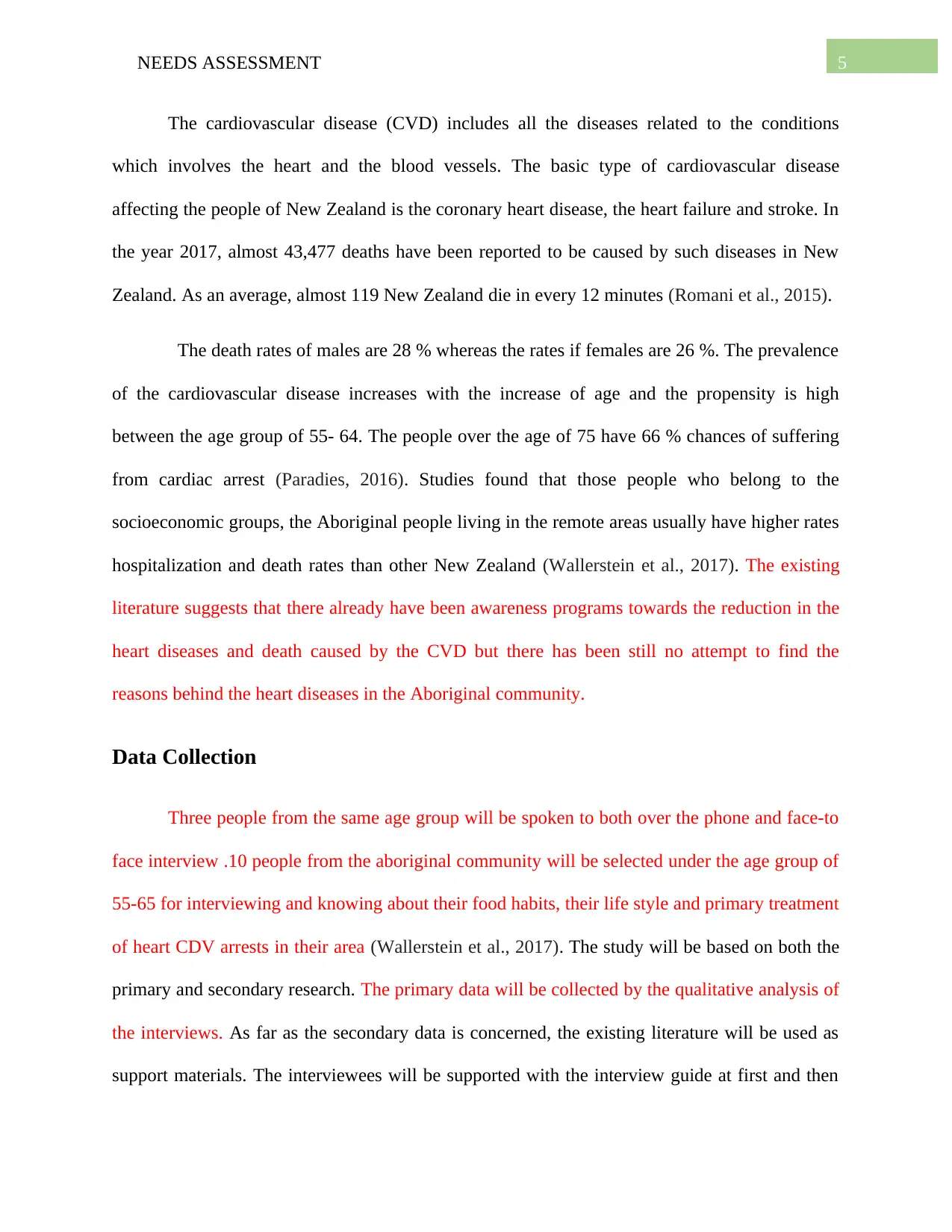
5NEEDS ASSESSMENT
The cardiovascular disease (CVD) includes all the diseases related to the conditions
which involves the heart and the blood vessels. The basic type of cardiovascular disease
affecting the people of New Zealand is the coronary heart disease, the heart failure and stroke. In
the year 2017, almost 43,477 deaths have been reported to be caused by such diseases in New
Zealand. As an average, almost 119 New Zealand die in every 12 minutes (Romani et al., 2015).
The death rates of males are 28 % whereas the rates if females are 26 %. The prevalence
of the cardiovascular disease increases with the increase of age and the propensity is high
between the age group of 55- 64. The people over the age of 75 have 66 % chances of suffering
from cardiac arrest (Paradies, 2016). Studies found that those people who belong to the
socioeconomic groups, the Aboriginal people living in the remote areas usually have higher rates
hospitalization and death rates than other New Zealand (Wallerstein et al., 2017). The existing
literature suggests that there already have been awareness programs towards the reduction in the
heart diseases and death caused by the CVD but there has been still no attempt to find the
reasons behind the heart diseases in the Aboriginal community.
Data Collection
Three people from the same age group will be spoken to both over the phone and face-to
face interview .10 people from the aboriginal community will be selected under the age group of
55-65 for interviewing and knowing about their food habits, their life style and primary treatment
of heart CDV arrests in their area (Wallerstein et al., 2017). The study will be based on both the
primary and secondary research. The primary data will be collected by the qualitative analysis of
the interviews. As far as the secondary data is concerned, the existing literature will be used as
support materials. The interviewees will be supported with the interview guide at first and then
The cardiovascular disease (CVD) includes all the diseases related to the conditions
which involves the heart and the blood vessels. The basic type of cardiovascular disease
affecting the people of New Zealand is the coronary heart disease, the heart failure and stroke. In
the year 2017, almost 43,477 deaths have been reported to be caused by such diseases in New
Zealand. As an average, almost 119 New Zealand die in every 12 minutes (Romani et al., 2015).
The death rates of males are 28 % whereas the rates if females are 26 %. The prevalence
of the cardiovascular disease increases with the increase of age and the propensity is high
between the age group of 55- 64. The people over the age of 75 have 66 % chances of suffering
from cardiac arrest (Paradies, 2016). Studies found that those people who belong to the
socioeconomic groups, the Aboriginal people living in the remote areas usually have higher rates
hospitalization and death rates than other New Zealand (Wallerstein et al., 2017). The existing
literature suggests that there already have been awareness programs towards the reduction in the
heart diseases and death caused by the CVD but there has been still no attempt to find the
reasons behind the heart diseases in the Aboriginal community.
Data Collection
Three people from the same age group will be spoken to both over the phone and face-to
face interview .10 people from the aboriginal community will be selected under the age group of
55-65 for interviewing and knowing about their food habits, their life style and primary treatment
of heart CDV arrests in their area (Wallerstein et al., 2017). The study will be based on both the
primary and secondary research. The primary data will be collected by the qualitative analysis of
the interviews. As far as the secondary data is concerned, the existing literature will be used as
support materials. The interviewees will be supported with the interview guide at first and then
⊘ This is a preview!⊘
Do you want full access?
Subscribe today to unlock all pages.

Trusted by 1+ million students worldwide
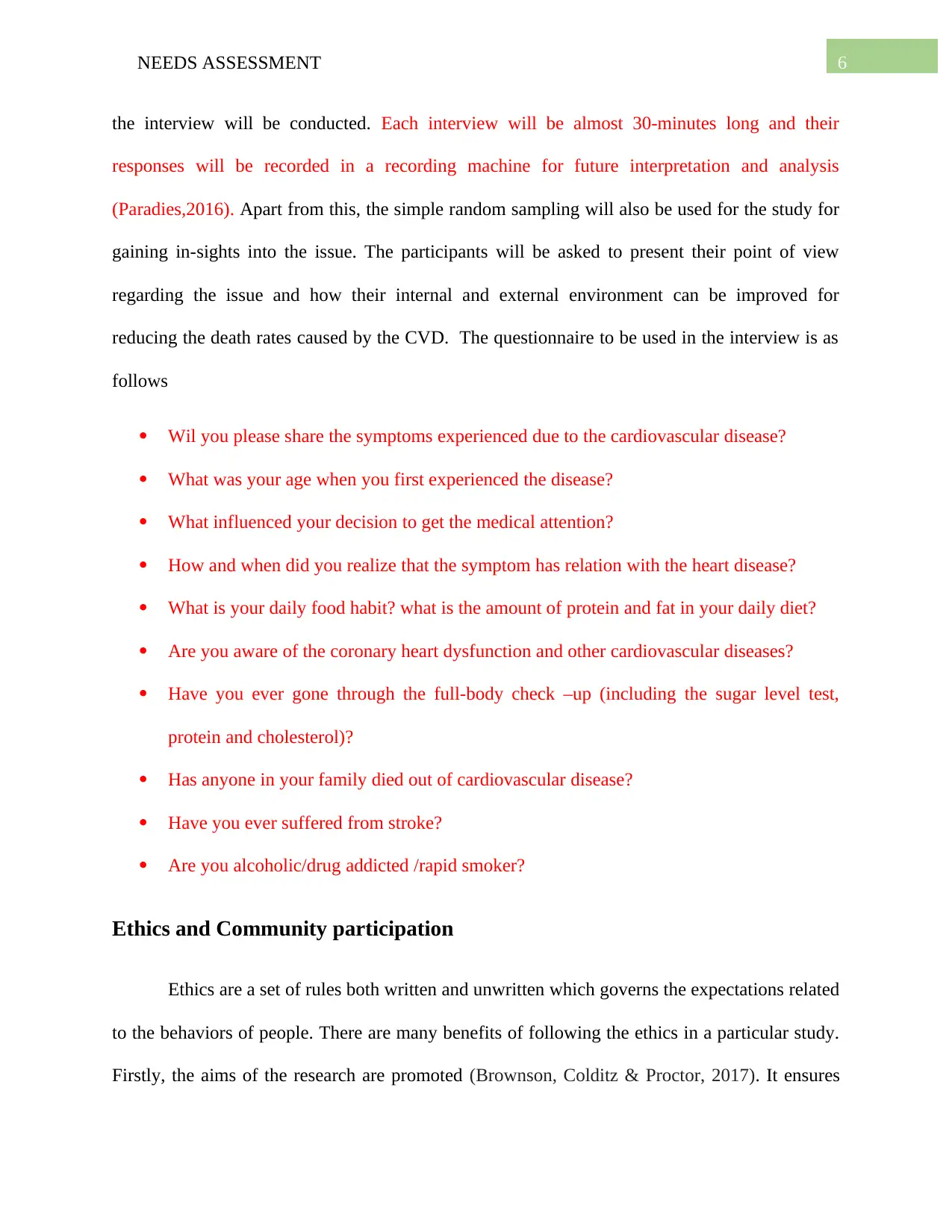
6NEEDS ASSESSMENT
the interview will be conducted. Each interview will be almost 30-minutes long and their
responses will be recorded in a recording machine for future interpretation and analysis
(Paradies,2016). Apart from this, the simple random sampling will also be used for the study for
gaining in-sights into the issue. The participants will be asked to present their point of view
regarding the issue and how their internal and external environment can be improved for
reducing the death rates caused by the CVD. The questionnaire to be used in the interview is as
follows
Wil you please share the symptoms experienced due to the cardiovascular disease?
What was your age when you first experienced the disease?
What influenced your decision to get the medical attention?
How and when did you realize that the symptom has relation with the heart disease?
What is your daily food habit? what is the amount of protein and fat in your daily diet?
Are you aware of the coronary heart dysfunction and other cardiovascular diseases?
Have you ever gone through the full-body check –up (including the sugar level test,
protein and cholesterol)?
Has anyone in your family died out of cardiovascular disease?
Have you ever suffered from stroke?
Are you alcoholic/drug addicted /rapid smoker?
Ethics and Community participation
Ethics are a set of rules both written and unwritten which governs the expectations related
to the behaviors of people. There are many benefits of following the ethics in a particular study.
Firstly, the aims of the research are promoted (Brownson, Colditz & Proctor, 2017). It ensures
the interview will be conducted. Each interview will be almost 30-minutes long and their
responses will be recorded in a recording machine for future interpretation and analysis
(Paradies,2016). Apart from this, the simple random sampling will also be used for the study for
gaining in-sights into the issue. The participants will be asked to present their point of view
regarding the issue and how their internal and external environment can be improved for
reducing the death rates caused by the CVD. The questionnaire to be used in the interview is as
follows
Wil you please share the symptoms experienced due to the cardiovascular disease?
What was your age when you first experienced the disease?
What influenced your decision to get the medical attention?
How and when did you realize that the symptom has relation with the heart disease?
What is your daily food habit? what is the amount of protein and fat in your daily diet?
Are you aware of the coronary heart dysfunction and other cardiovascular diseases?
Have you ever gone through the full-body check –up (including the sugar level test,
protein and cholesterol)?
Has anyone in your family died out of cardiovascular disease?
Have you ever suffered from stroke?
Are you alcoholic/drug addicted /rapid smoker?
Ethics and Community participation
Ethics are a set of rules both written and unwritten which governs the expectations related
to the behaviors of people. There are many benefits of following the ethics in a particular study.
Firstly, the aims of the research are promoted (Brownson, Colditz & Proctor, 2017). It ensures
Paraphrase This Document
Need a fresh take? Get an instant paraphrase of this document with our AI Paraphraser
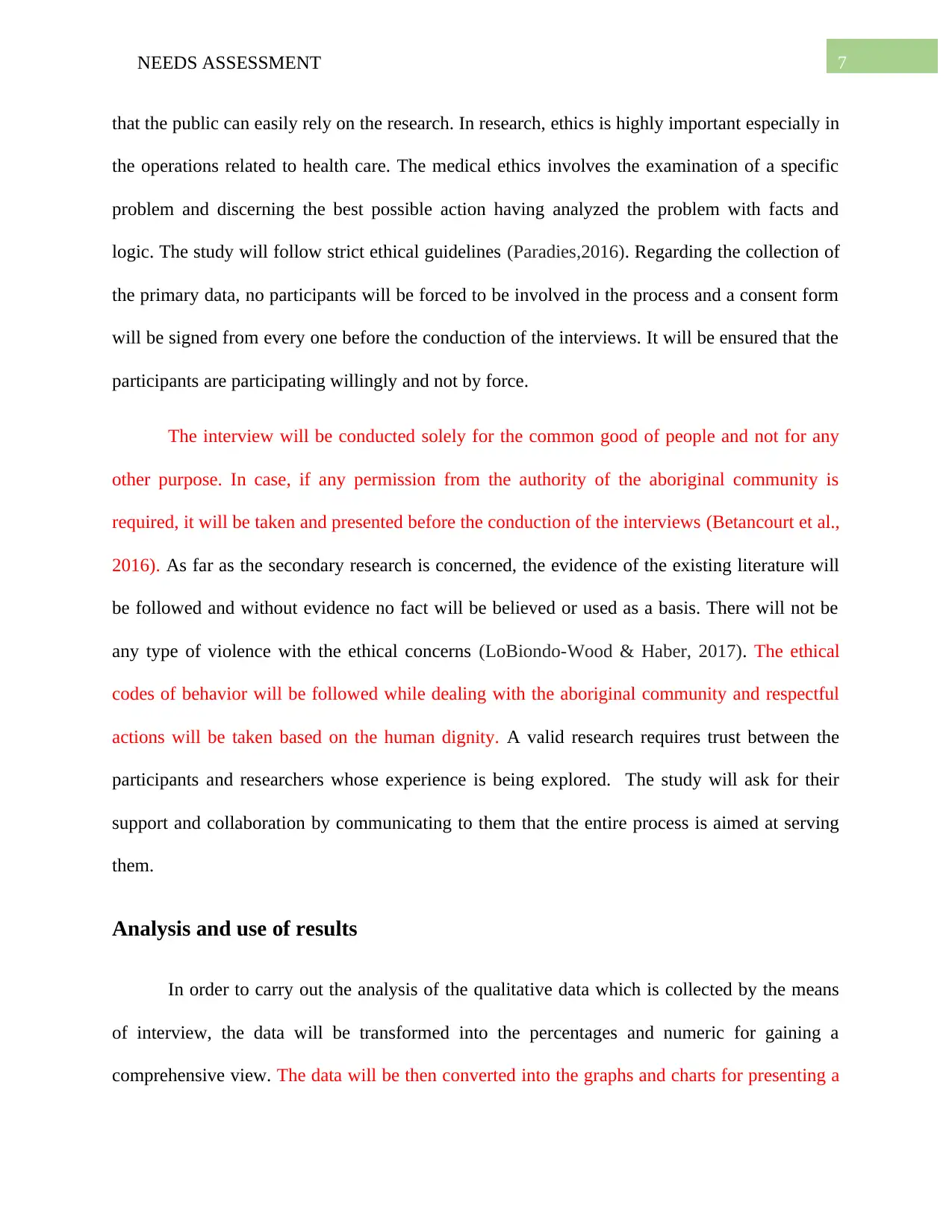
7NEEDS ASSESSMENT
that the public can easily rely on the research. In research, ethics is highly important especially in
the operations related to health care. The medical ethics involves the examination of a specific
problem and discerning the best possible action having analyzed the problem with facts and
logic. The study will follow strict ethical guidelines (Paradies,2016). Regarding the collection of
the primary data, no participants will be forced to be involved in the process and a consent form
will be signed from every one before the conduction of the interviews. It will be ensured that the
participants are participating willingly and not by force.
The interview will be conducted solely for the common good of people and not for any
other purpose. In case, if any permission from the authority of the aboriginal community is
required, it will be taken and presented before the conduction of the interviews (Betancourt et al.,
2016). As far as the secondary research is concerned, the evidence of the existing literature will
be followed and without evidence no fact will be believed or used as a basis. There will not be
any type of violence with the ethical concerns (LoBiondo-Wood & Haber, 2017). The ethical
codes of behavior will be followed while dealing with the aboriginal community and respectful
actions will be taken based on the human dignity. A valid research requires trust between the
participants and researchers whose experience is being explored. The study will ask for their
support and collaboration by communicating to them that the entire process is aimed at serving
them.
Analysis and use of results
In order to carry out the analysis of the qualitative data which is collected by the means
of interview, the data will be transformed into the percentages and numeric for gaining a
comprehensive view. The data will be then converted into the graphs and charts for presenting a
that the public can easily rely on the research. In research, ethics is highly important especially in
the operations related to health care. The medical ethics involves the examination of a specific
problem and discerning the best possible action having analyzed the problem with facts and
logic. The study will follow strict ethical guidelines (Paradies,2016). Regarding the collection of
the primary data, no participants will be forced to be involved in the process and a consent form
will be signed from every one before the conduction of the interviews. It will be ensured that the
participants are participating willingly and not by force.
The interview will be conducted solely for the common good of people and not for any
other purpose. In case, if any permission from the authority of the aboriginal community is
required, it will be taken and presented before the conduction of the interviews (Betancourt et al.,
2016). As far as the secondary research is concerned, the evidence of the existing literature will
be followed and without evidence no fact will be believed or used as a basis. There will not be
any type of violence with the ethical concerns (LoBiondo-Wood & Haber, 2017). The ethical
codes of behavior will be followed while dealing with the aboriginal community and respectful
actions will be taken based on the human dignity. A valid research requires trust between the
participants and researchers whose experience is being explored. The study will ask for their
support and collaboration by communicating to them that the entire process is aimed at serving
them.
Analysis and use of results
In order to carry out the analysis of the qualitative data which is collected by the means
of interview, the data will be transformed into the percentages and numeric for gaining a
comprehensive view. The data will be then converted into the graphs and charts for presenting a
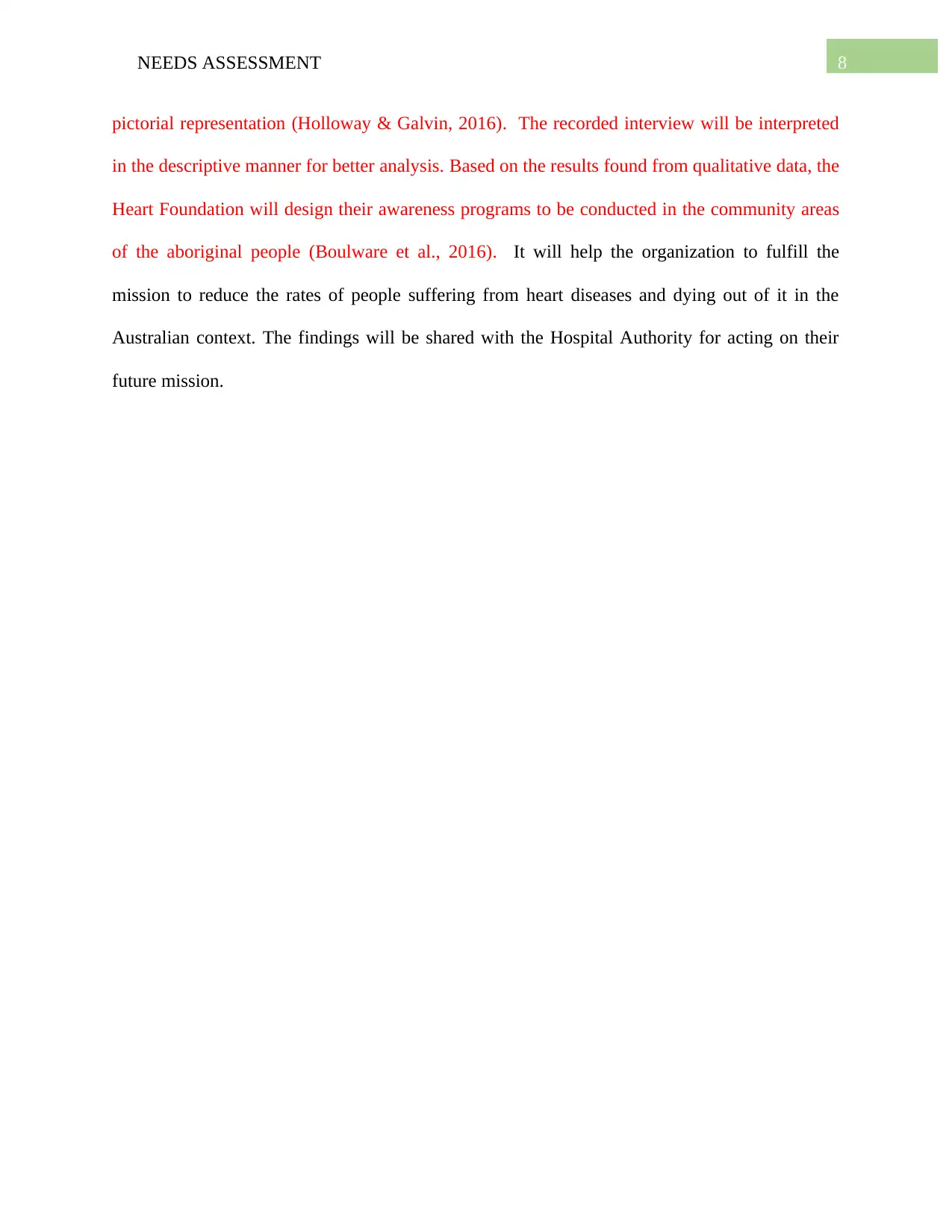
8NEEDS ASSESSMENT
pictorial representation (Holloway & Galvin, 2016). The recorded interview will be interpreted
in the descriptive manner for better analysis. Based on the results found from qualitative data, the
Heart Foundation will design their awareness programs to be conducted in the community areas
of the aboriginal people (Boulware et al., 2016). It will help the organization to fulfill the
mission to reduce the rates of people suffering from heart diseases and dying out of it in the
Australian context. The findings will be shared with the Hospital Authority for acting on their
future mission.
pictorial representation (Holloway & Galvin, 2016). The recorded interview will be interpreted
in the descriptive manner for better analysis. Based on the results found from qualitative data, the
Heart Foundation will design their awareness programs to be conducted in the community areas
of the aboriginal people (Boulware et al., 2016). It will help the organization to fulfill the
mission to reduce the rates of people suffering from heart diseases and dying out of it in the
Australian context. The findings will be shared with the Hospital Authority for acting on their
future mission.
⊘ This is a preview!⊘
Do you want full access?
Subscribe today to unlock all pages.

Trusted by 1+ million students worldwide
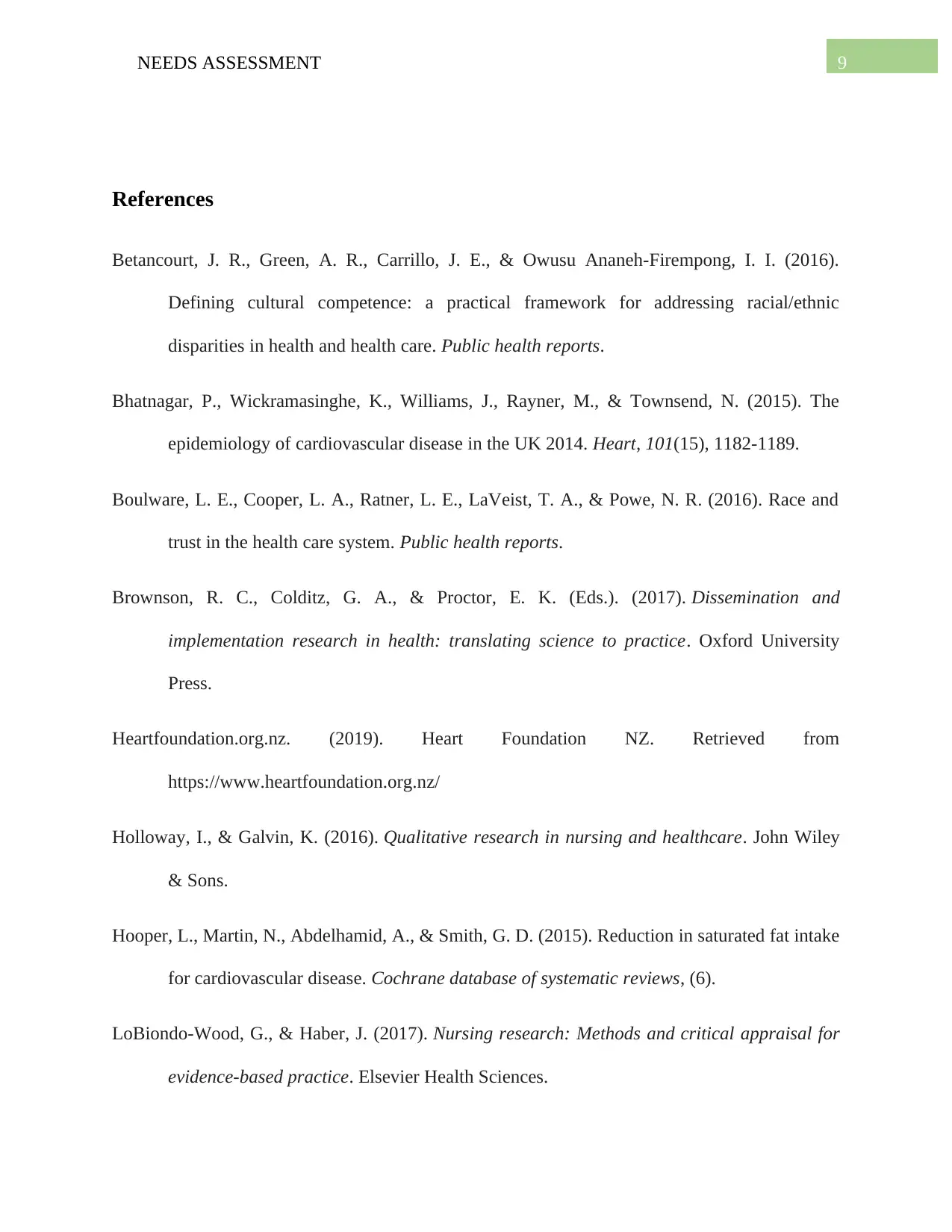
9NEEDS ASSESSMENT
References
Betancourt, J. R., Green, A. R., Carrillo, J. E., & Owusu Ananeh-Firempong, I. I. (2016).
Defining cultural competence: a practical framework for addressing racial/ethnic
disparities in health and health care. Public health reports.
Bhatnagar, P., Wickramasinghe, K., Williams, J., Rayner, M., & Townsend, N. (2015). The
epidemiology of cardiovascular disease in the UK 2014. Heart, 101(15), 1182-1189.
Boulware, L. E., Cooper, L. A., Ratner, L. E., LaVeist, T. A., & Powe, N. R. (2016). Race and
trust in the health care system. Public health reports.
Brownson, R. C., Colditz, G. A., & Proctor, E. K. (Eds.). (2017). Dissemination and
implementation research in health: translating science to practice. Oxford University
Press.
Heartfoundation.org.nz. (2019). Heart Foundation NZ. Retrieved from
https://www.heartfoundation.org.nz/
Holloway, I., & Galvin, K. (2016). Qualitative research in nursing and healthcare. John Wiley
& Sons.
Hooper, L., Martin, N., Abdelhamid, A., & Smith, G. D. (2015). Reduction in saturated fat intake
for cardiovascular disease. Cochrane database of systematic reviews, (6).
LoBiondo-Wood, G., & Haber, J. (2017). Nursing research: Methods and critical appraisal for
evidence-based practice. Elsevier Health Sciences.
References
Betancourt, J. R., Green, A. R., Carrillo, J. E., & Owusu Ananeh-Firempong, I. I. (2016).
Defining cultural competence: a practical framework for addressing racial/ethnic
disparities in health and health care. Public health reports.
Bhatnagar, P., Wickramasinghe, K., Williams, J., Rayner, M., & Townsend, N. (2015). The
epidemiology of cardiovascular disease in the UK 2014. Heart, 101(15), 1182-1189.
Boulware, L. E., Cooper, L. A., Ratner, L. E., LaVeist, T. A., & Powe, N. R. (2016). Race and
trust in the health care system. Public health reports.
Brownson, R. C., Colditz, G. A., & Proctor, E. K. (Eds.). (2017). Dissemination and
implementation research in health: translating science to practice. Oxford University
Press.
Heartfoundation.org.nz. (2019). Heart Foundation NZ. Retrieved from
https://www.heartfoundation.org.nz/
Holloway, I., & Galvin, K. (2016). Qualitative research in nursing and healthcare. John Wiley
& Sons.
Hooper, L., Martin, N., Abdelhamid, A., & Smith, G. D. (2015). Reduction in saturated fat intake
for cardiovascular disease. Cochrane database of systematic reviews, (6).
LoBiondo-Wood, G., & Haber, J. (2017). Nursing research: Methods and critical appraisal for
evidence-based practice. Elsevier Health Sciences.
Paraphrase This Document
Need a fresh take? Get an instant paraphrase of this document with our AI Paraphraser
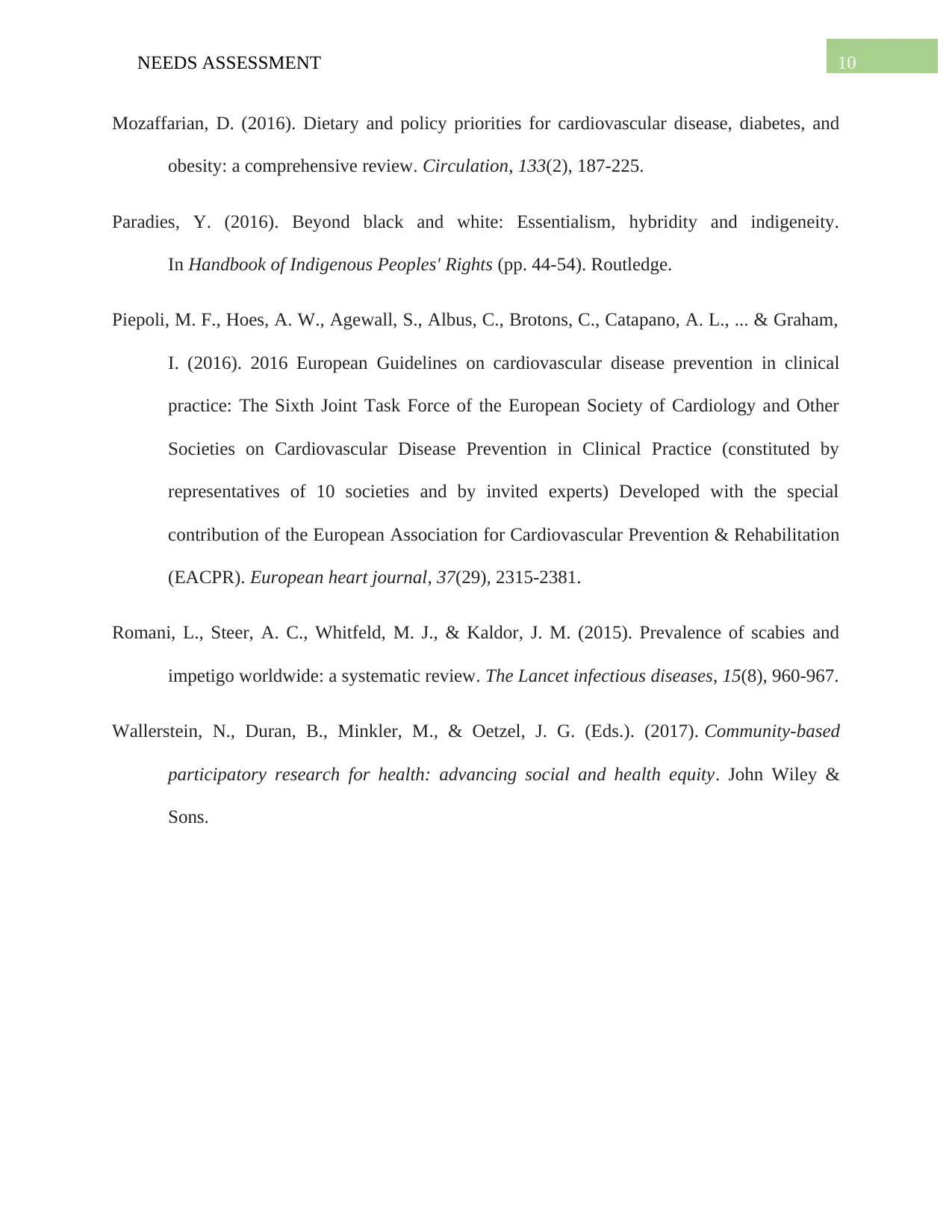
10NEEDS ASSESSMENT
Mozaffarian, D. (2016). Dietary and policy priorities for cardiovascular disease, diabetes, and
obesity: a comprehensive review. Circulation, 133(2), 187-225.
Paradies, Y. (2016). Beyond black and white: Essentialism, hybridity and indigeneity.
In Handbook of Indigenous Peoples' Rights (pp. 44-54). Routledge.
Piepoli, M. F., Hoes, A. W., Agewall, S., Albus, C., Brotons, C., Catapano, A. L., ... & Graham,
I. (2016). 2016 European Guidelines on cardiovascular disease prevention in clinical
practice: The Sixth Joint Task Force of the European Society of Cardiology and Other
Societies on Cardiovascular Disease Prevention in Clinical Practice (constituted by
representatives of 10 societies and by invited experts) Developed with the special
contribution of the European Association for Cardiovascular Prevention & Rehabilitation
(EACPR). European heart journal, 37(29), 2315-2381.
Romani, L., Steer, A. C., Whitfeld, M. J., & Kaldor, J. M. (2015). Prevalence of scabies and
impetigo worldwide: a systematic review. The Lancet infectious diseases, 15(8), 960-967.
Wallerstein, N., Duran, B., Minkler, M., & Oetzel, J. G. (Eds.). (2017). Community-based
participatory research for health: advancing social and health equity. John Wiley &
Sons.
Mozaffarian, D. (2016). Dietary and policy priorities for cardiovascular disease, diabetes, and
obesity: a comprehensive review. Circulation, 133(2), 187-225.
Paradies, Y. (2016). Beyond black and white: Essentialism, hybridity and indigeneity.
In Handbook of Indigenous Peoples' Rights (pp. 44-54). Routledge.
Piepoli, M. F., Hoes, A. W., Agewall, S., Albus, C., Brotons, C., Catapano, A. L., ... & Graham,
I. (2016). 2016 European Guidelines on cardiovascular disease prevention in clinical
practice: The Sixth Joint Task Force of the European Society of Cardiology and Other
Societies on Cardiovascular Disease Prevention in Clinical Practice (constituted by
representatives of 10 societies and by invited experts) Developed with the special
contribution of the European Association for Cardiovascular Prevention & Rehabilitation
(EACPR). European heart journal, 37(29), 2315-2381.
Romani, L., Steer, A. C., Whitfeld, M. J., & Kaldor, J. M. (2015). Prevalence of scabies and
impetigo worldwide: a systematic review. The Lancet infectious diseases, 15(8), 960-967.
Wallerstein, N., Duran, B., Minkler, M., & Oetzel, J. G. (Eds.). (2017). Community-based
participatory research for health: advancing social and health equity. John Wiley &
Sons.
1 out of 11
Related Documents
Your All-in-One AI-Powered Toolkit for Academic Success.
+13062052269
info@desklib.com
Available 24*7 on WhatsApp / Email
![[object Object]](/_next/static/media/star-bottom.7253800d.svg)
Unlock your academic potential
Copyright © 2020–2025 A2Z Services. All Rights Reserved. Developed and managed by ZUCOL.




